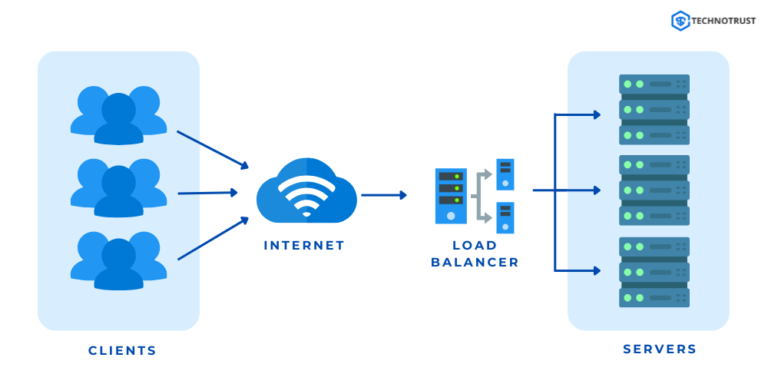In today’s, competitive digital world performance, and reliability are crucial for any business that relies on web applications. That’s where load balancers come into play. These powerful tools ensure that your website or app remains fast, available, and resilient, no matter how much traffic comes on the website or application. But what exactly is a load balancer, and how does it work?
In this post, we’ll explore what is load balancer, its benefits, how it works, the available types, and how Technotrust Solutions can help you implement the perfect load-balancing strategy.
What is a Load Balancer?
A load balancer is a system (either hardware or software) designed to distribute incoming traffic across multiple servers. Its job is to ensure that no single server gets overwhelmed with too much traffic, which can cause slow performance or downtime.
Think of it like a traffic cop, directing web traffic to different servers to ensure smooth flow and prevent congestion. Load balancers are key to high-performing, scalable, and fault-tolerant systems that deliver optimal user experiences even under heavy traffic.
By using a load balancer, companies can avoid the risk of downtime, improve response times, and ensure that their applications are always accessible and responsive.
What Are the Benefits of Load Balancing?
There are several reasons why businesses should implement load balancing in their infrastructure. Let’s explore the key benefits of load balancers and what advantages businesses get after implementation:
- Improved Reliability and Uptime: Load balancing ensures that if one server goes down or experiences issues, traffic can be redirected to healthy servers. This minimizes the chances of your application being unavailable and ensures that your customers can always access your services.
- Scalability: As your business grows, your website or app will naturally attract more users. Load balancers make it easier to scale your infrastructure by adding more servers to handle the increased load. This allows your business to grow without worrying about performance bottlenecks.
- Enhanced Performance: Load balancers help to optimize resource utilization by ensuring that no single server is overburdened. This results in better response times for users and a smoother experience overall.
- Fault Tolerance: Load balancing increases fault tolerance by constantly monitoring the health of the servers. If one server becomes unhealthy, the load balancer automatically reroutes traffic to the next available server, minimizing disruptions.
- Cost Efficiency: By efficiently distributing traffic and preventing overload, load balancing can help prevent costly server downtime or the need for unnecessary additional infrastructure.
How Does a Load Balancer Work?

At its core, a load balancer sits between the user and your backend servers. Here’s how it works:
- User Request: When a user sends a request (for example, loading a webpage), the load balancer receives it first.
- Traffic Distribution: The load balancer determines which server should handle the request. It uses predefined algorithms (like round-robin or least connections) to make this decision.
- Routing Traffic: Once a decision is made, the load balancer routes the user’s request to the selected server.
- Response: The server processes the request and sends the response back to the load balancer, which then sends it to the user.
Additionally, many load balancers perform health checks on the servers to ensure they’re capable of handling traffic. If a server is down or unhealthy, the load balancer can route traffic to another server.
What Types of Load Balancers Are There?
There are several types of load balancers, and choosing the right one depends on your business needs and infrastructure.
- Hardware Load Balancers: These are physical devices placed in your data center to distribute traffic. While they offer high performance and reliability, they tend to be more expensive and less flexible than software-based solutions.
- Software Load Balancers: Software load balancers run on general-purpose servers and can be more flexible and cost-effective than hardware solutions. They are suitable for cloud-based environments and offer the ability to scale quickly.
- Cloud Load Balancers: Many cloud providers like AWS, Azure, and Google Cloud offer load-balancing services. These are often easy to configure and scale, and they integrate seamlessly with other cloud services.
- Layer 4 vs. Layer 7 Load Balancers
- Layer 4 Load Balancing (Transport Layer): Works at the TCP/UDP level and routes traffic based on IP addresses and ports.
- Layer 7 Load Balancing (Application Layer): Operates at the application level, making decisions based on the content of the request (like HTTP headers, cookies, etc.).
How Technotrust Solutions Can Help with Load Balancing
At Technotrust Solutions, we understand that every business has unique needs when it comes to scalability, performance, and security. That’s why we offer tailored load-balancing solutions that ensure your infrastructure remains resilient and responsive, no matter what.
Why Choose Us?
Expert Consultation
Custom Solutions
24/7 Monitoring
Seamless Integration
Whether you’re a growing startup or an established enterprise, Technotrust Solutions has the expertise and tools to keep your website or app performing at its best.
Conclusion
In today’s competitive digital landscape, ensuring your web applications are fast, available, and reliable is more important than ever. Load balancing is a critical component in achieving this, allowing businesses to scale, optimize performance, and improve fault tolerance. By understanding how load balancers work and choosing the right solution, you can provide your users with a seamless experience and keep your services up and running at all times.
If you need help implementing or optimizing your load-balancing strategy, don’t hesitate to reach out to Technotrust Solutions. We’re here to help you build a robust, scalable infrastructure that supports your business goals.


